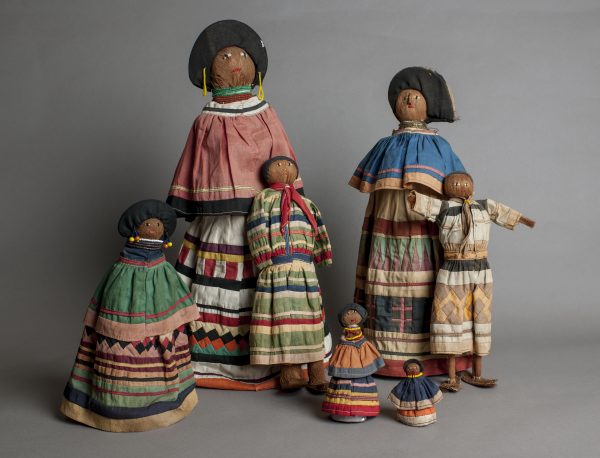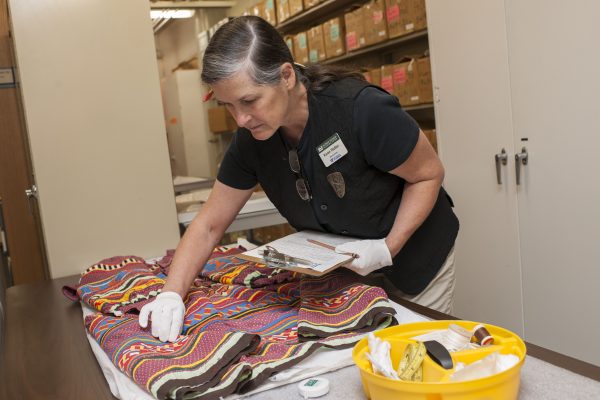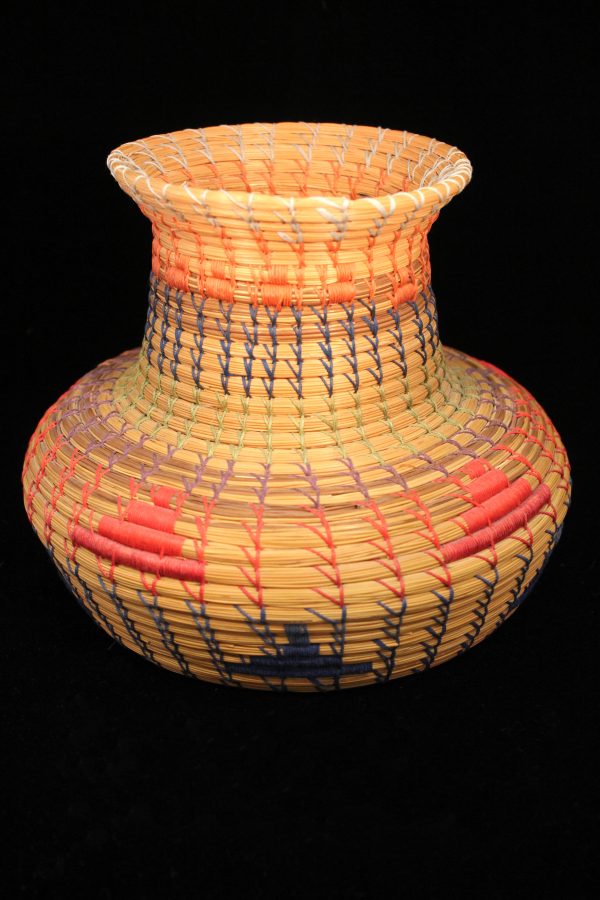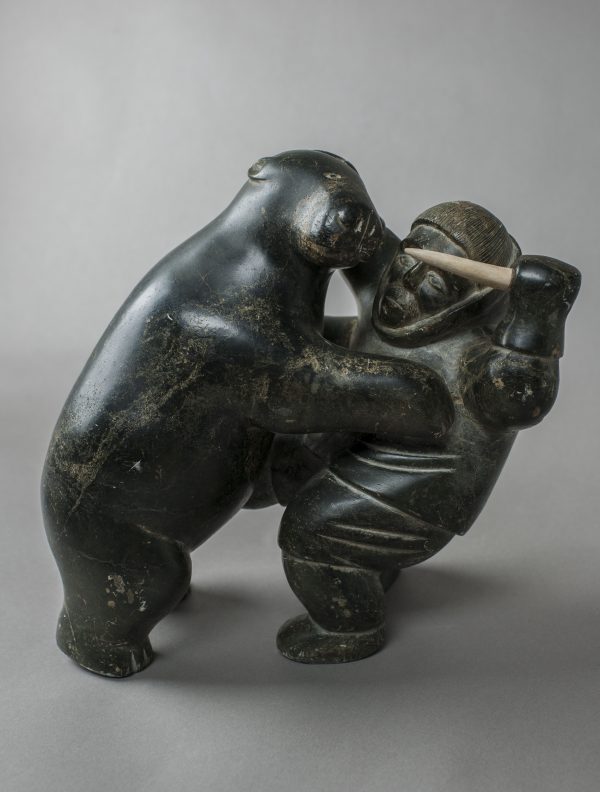
Florida Museum photo by Kristen Grace
By his mid-20s, Keith Reeves had traveled the world. When he settled in Florida in the 1960s, however, it was in many ways an alien place: No ancient monuments like the pyramids he climbed in Egypt or mountains like those on South Pacific islands where he lived as a “Navy brat,” but a wet-hot, often harsh, environment, devastated every so often by hurricane force winds howling through palms trees and toppling condos. While adjusting to this ominous landscape, Reeves decided to explore what he calls the “subtleties of Florida,” namely its indigenous people, as catharsis.
“He complained about the flat landscape and he complained about the Florida vegetation,” said Sara Reeves, Keith’s wife, who first encouraged him to give Florida a chance. “Every place has its own beauty, you just have to find it.”
It was the bright colors of Seminole Indian art and wear that first caught Keith Reeves’ eye, a “riot of color: bright red or bright yellow, or a combination of blue and yellow and orange and green,” and he began to collect everything from patchwork clothing to moccasins to early photographs.
“I will be honest, it is an addiction,” Reeves said. “But my addiction isn’t just about the aesthetics of these objects, but the research and history involved. Sometimes, an object’s story is as important as the object itself.”
Since 2009, the Reeves have donated 47 Florida Seminole and Miccosukee Indian items to the Florida Museum of Natural History, in addition to pieces from tribes outside the state, including the Alaskan Inuit. The Reeves’ 2014 donation is expected to bring the total value of their gifts to more than $1 million.
“As our house began to look more like museum than a home, we decided it was time to share the collection and make it available to the public,” Keith Reeves said.
“You cannot stick this stuff away and hide it from people,” Sara Reeves added. “These were things they used and wore, not just things they sold. These pieces tell a story about who the people really were that used and made them.”
The Florida Museum does not have a budget for acquiring specimens and artifacts, including ethnographic items, so it depends on gifts from donors like the Reeves.

Florida Museum photo by Kristen Grace
Bill Marquardt, curator of the Museum’s Florida ethnographic collection, said much of what has been written about Florida’s native peoples has to do with conflicts between Indians and non-Indians. However, the pieces the Reeves collect tell a deeper story—one spanning centuries—of family, religion and tradition.
“It is important to know this history, but there is so much more to the story of the Seminole and Miccosukee,” Marquardt said. “They are still very much alive today, and while they have their own identity and value their traditions, they also live in the present and think about their future, as do all Floridians. By maintaining collections of their art and technology, we help provide a link to the past for them, and a bridge to understanding for others.”
The Museum’s ethnographic collections are like cultural libraries, Marquardt said, serving as resources for continued learning. When Seminole tribal member Pedro Zepeda, former traditional arts coordinator for Ah Tah Thi Ki, the Seminole Tribe’s museum, visited the Museum’s Seminole collections, he was interested in the details of some of the museum’s older baskets and clothing, which helped him in his teaching role back home.
“But it’s a two-way street,” Marquardt said. “Pedro is very knowledgeable, and he was able to tell us some things about our collections that we didn’t know. He explained that a hat in our collection from the 1850s was probably Delaware, not Seminole. Pedro said that during the Third Seminole War, some Delaware Indians acted as scouts for the U.S. Army.”
Items share insights to native cultures
Similarly, the Florida’s Museum’s photography archives document the activities of ancestors of today’s living Indian people and sometimes provide snapshots of pieces in the Reeves collection during their prime. Several years ago, Keith Reeves noticed a photograph of Jumper, once the spiritual adviser to the Seminole Chief Micanopy, sitting next to Billy Bowlegs, another Seminole leader, in an issue of the London Gazette from the 1800s. In the photograph, Jumper wore a sash identical to one in Reeves’ personal collection. He eventually tracked the original photograph to a collector in New England, and immediately hopped on a plane to see it in person.
“It was one of those things that gives you goose bumps, if you know what I mean,” Reeves said. “The fact that we could tie an item to an individual was one of those miracles that happens every now and then. The sash is probably my favorite piece, so it hasn’t made its way to the museum just yet.”
Detailed study of Seminole clothing, such as Jumper’s sash and the longshirt donated by the Reeves in 2012, reveals how the garments were made, worn and altered through the years. A basket also donated by the Reeves in 2012 turned out to be particularly interesting, and exemplifies the importance of ethnographic research at the Florida Museum, Marquardt said.

Florida Museum photo by Austin Bell
“One of our former graduate students, Austin Bell, who is now the curator of the Marco Island Museum, investigated the basket, and proposed that it was the work of Seminole artist Paul Billie,” Marquardt said. “Billie died in his early ’40s, cutting short the career of one of the tribe’s most renowned artists. He was best known as a painter, but he experimented freely with other media, including basketry, traditionally a woman’s art. The basket features triangular step designs, which are very unusual, as is the combined use of sweet grass and pine needles.”
The Seminole Indians are a group originally formed by independent people of Creek Indian descent who migrated into Florida during a time of intense struggles in the southeastern U.S. Like Reeves, they came to Florida and never left. Their very name, the word Seminole, means “untamed.” For most of their history, the Seminole community has remained essentially closed to outsiders, other than escaped African American slaves prior to end of the Civil War.
Keith Reeves readily admits that gaining access to Native American communities is anything but easy. One of his favorite heroines of the early 20th century is deaconess Harriet Bedell, who successfully formed intimate bonds with the Seminoles during the aftermath of the Great Depression.
Bedell founded the Glades Cross Mission in South Florida and set out to help the Seminoles improve the group’s economic circumstances. To do this, she encouraged tribal women to revive the nearly extinct traditions of doll-making and basket weaving. The dolls that passed her quality standard, meaning strictly traditional, were bought and piled into her Model-T, then driven to New York where Bedell would sell them and use the profits to support the mission. Others were sold to South Florida tourists. Bedell continued serving the Seminoles until 1960, when Hurricane Donna ripped through Florida and the East Coast, leaving the mission in ruins.
Bedell’s mission was a casualty of Florida weather, but the dolls remained in circulation. Reeves collected many such Seminoles dolls over the years, donating 27 from the early 20th century tourism industry to the Florida Museum. The dolls are snapshots of traditional Seminole fashion, Marquardt said, and help researchers understand changes in fashion over time. The dolls and similar crafts are also available for native people to learn from and replicate skills.
“It’s living and breathing culture,” Marquardt said. “Not part of the ancient past alone, but part of Florida today.”
The Reeves have experienced these living, breathing native cultures first-hand. In 1995, on a bright day in Arizona where the air is dry and the mesa has been the sacred land of the Hopi for at least 1,000 years, Sara Reeves was adopted by Susie Youvella, a Hopi woman and close friend who was severely ill. It happened unexpectedly.
“Susie got in front of me and started saying things in Hopi,” Sara Reeves recalls. “The tears just started flowing. I knew what was happening without knowing.”
Youvella and her family continued to speak in Hopi, while Reeves clasped the armrests of a chair in Youvella’s living room. Surreal showers of cornmeal sprinkled over her. The Hopi have used cornmeal for rituals and as spiritual offerings for centuries.
Youvella put the cornmeal into Reeves’ hand and folded her fingers over slowly. Involuntary tears soaked Reeves’ face. Youvella’s daughter finally said to her, “Mother has just adopted you. Your name is Kachin’Mana (Kachina Girl) and you belong to the Parrot Clan.”
“We walked to the east edge of the mesa, I said a prayer and threw the cornmeal over the edge,” Reeves said. “My Hopi brother, Silas, hugged me and said, ‘Sis, we’re losing our mother,’ and we both stood there and sobbed.”
Keith Reeves said once people with flesh like his and Sara’s took the land of Susie’s ancestors and other natives, but none of that mattered that day on the mesa. They were family.
Preserving native peoples’ artistic expression
The Reeves say their “addiction” is about saving art and preserving history.
“As an architect, I’m driven and attracted to aesthetics, to the beauty and worship of the visual,” Keith Reeves said. “This is an extension of that, the appreciation of the beauty of things.”
But of course something other than rescuing Native American culture is at work here, something other than an addiction to collecting. When you ask the Reeves to describe the nature of native art, a driving force behind the Reeves’ years of collecting is revealed: an aversion to Native American stereotypes and the desire to share the complex cultures of native peoples with the masses.

Florida Museum photo by Kristen Grace
“The Seminoles were artists,” Keith Reeves said. “How could anyone ever think of them as primitive? They were producing art in the middle of nowhere, in the middle of the Florida swamp, and it is just absolutely amazing. Once you take a deeper look, beyond the primitive nature of their camps, made out of necessity, you see the reality—a reality that is evident in their art. You begin to understand that the knowledge of nature and life possessed by native peoples was superior to what the ‘white man’ had.”
Although it is a challenge for native tribes to maintain their unique cultures while also functioning in mainstream society, artistic expression like that found in the Reeves collection still exists in modern native communities, Reeves said.
A large stone carving depicting the classic confrontation of a polar bear and an Inuit hunter sits on a shelf among other pieces of the Reeves collection at the Florida Museum. The bear has attacked the hunter and stands on its hind feet, its weight forcing the hunter back, yet he is about to strike back with his dagger.
“While the conclusion of the battle may seem pre-ordained, there are many instances in which Inuit hunters have not only survived but vanquished the bear and been celebrated in song and folklore,” Reeves said. “This type of art form, the Inuit carving of stone to depict life events, did not begin until the early 1950s and continues today as a viable expression of day-to-day events.”
Learn more about the South Florida Archaeology & Ethnography Collection at the Florida Museum.